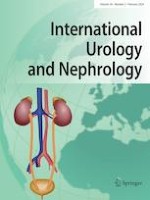Erschienen in:

30.09.2023 | Urology - Original Paper
Clear cell renal cell carcinoma cells show diffuse expression of phagocytotic markers through the identification of lysosome-rich eosinophilic granules
verfasst von:
Vasudevan D. Mahalingam, Oumaima S. Chaib, Hassan D. Kanaan, Jason M. Hafron, Ping L. Zhang
Erschienen in:
International Urology and Nephrology
|
Ausgabe 2/2024
Einloggen, um Zugang zu erhalten
Abstract
Background
Paneth cell-like granules (PCLG) in clear cell renal cell carcinomas (RCC) have previously been reported but were not found to express neuroendocrine markers. This study was to investigate if the eosinophilic granules (so called PCLG) were enlarged lysosomes.
Methods
A retrospective review of 72 different renal tumors was conducted which included 42 clear cell RCC, 16 papillary RCC, 6 chromophobe RCC, 5 clear cell papillary RCC, 2 urothelial carcinomas and 1 unclassified RCC. All tumors were evaluated for the eosinophilic granules on hematoxylin and eosin-stained sections. In addition, PAS-D staining, immunohistochemical stains, and electron microscopy were performed.
Results
The eosinophilic granules were found in 19% (8 out of 42) clear cell RCC, but not in the other renal tumor types. The granules stained positively for PAS-D and were also positive for lysosomal protein markers CD68 and lysozyme. Electron microscopy revealed that the eosinophilic granules were smooth ball-shaped structures in the cytoplasm, ranging in size from 0.8 to 1.4 µm. The overall findings indicate that the eosinophilic granules were best correlated with lysosomes.
Conclusions
The eosinophilic granules in clear cell RCC are expanded lysosomes, and this may be used as a unique feature for confirming the pathologic diagnosis of clear cell RCC. The findings further support the view that clear cell RCC have phagocytic capacity due to their containing abundant lysosomes in the cytoplasm.











